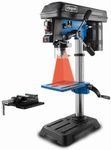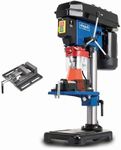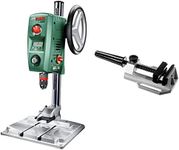Buying Guide for the Best Benchtop Drill Presses
When selecting a benchtop drill press, it's important to consider the specific tasks you plan to undertake and the materials you'll be working with. A drill press is a versatile tool that can provide precision and power for drilling holes in various materials, but choosing the right one involves understanding the key specifications that affect its performance and suitability for your needs. By evaluating these specifications, you can ensure that the drill press you choose will meet your requirements and provide reliable service for your projects.Motor PowerMotor power in a benchtop drill press is measured in horsepower (HP) and determines the tool's ability to handle different materials and drilling tasks. A more powerful motor can drill through tougher materials like metal and hardwood with ease, while a less powerful motor may be sufficient for softer materials like plastic or softwood. Typically, motor power ranges from 1/3 HP to 3/4 HP for benchtop models. If you plan to work with a variety of materials or require more power for larger bits, opt for a higher horsepower. For lighter, occasional use, a lower horsepower may suffice.
Speed SettingsSpeed settings on a drill press refer to the number of revolutions per minute (RPM) the drill bit can achieve. This is important because different materials and bit sizes require different speeds for optimal performance and to prevent damage. Benchtop drill presses often offer variable speed settings, ranging from around 500 RPM to 3000 RPM. For metal, slower speeds are generally better, while wood and plastic can be drilled at higher speeds. Consider a model with adjustable speeds if you plan to work with a variety of materials, as this will give you the flexibility to choose the right speed for each task.
Drill CapacityDrill capacity refers to the maximum size of the drill bit that the chuck can accommodate, as well as the maximum depth of hole the drill press can create. This is crucial for ensuring that the drill press can handle the size of the projects you intend to undertake. Common chuck sizes for benchtop models are 1/2 inch or 5/8 inch. If you need to drill larger holes, ensure the drill press has a larger chuck capacity. Additionally, consider the spindle travel, which indicates how deep the drill can go; more spindle travel allows for deeper holes.
Table Size and AdjustabilityThe table size and adjustability of a drill press affect the ease with which you can position and support your workpiece. A larger table provides more support for bigger pieces, while an adjustable table allows you to tilt and rotate the workpiece for angled drilling. Look for a table that can be easily adjusted in height and angle to accommodate different drilling tasks. If you frequently work with large or awkwardly shaped materials, a larger, more adjustable table will be beneficial.
Build Quality and StabilityBuild quality and stability are important for ensuring that the drill press operates smoothly and accurately. A well-built drill press will have a sturdy frame and base, reducing vibrations and improving precision. Look for models made from durable materials like cast iron or steel, which provide better stability and longevity. If precision is a priority for your projects, prioritize a model with a solid build to minimize movement during operation.
















